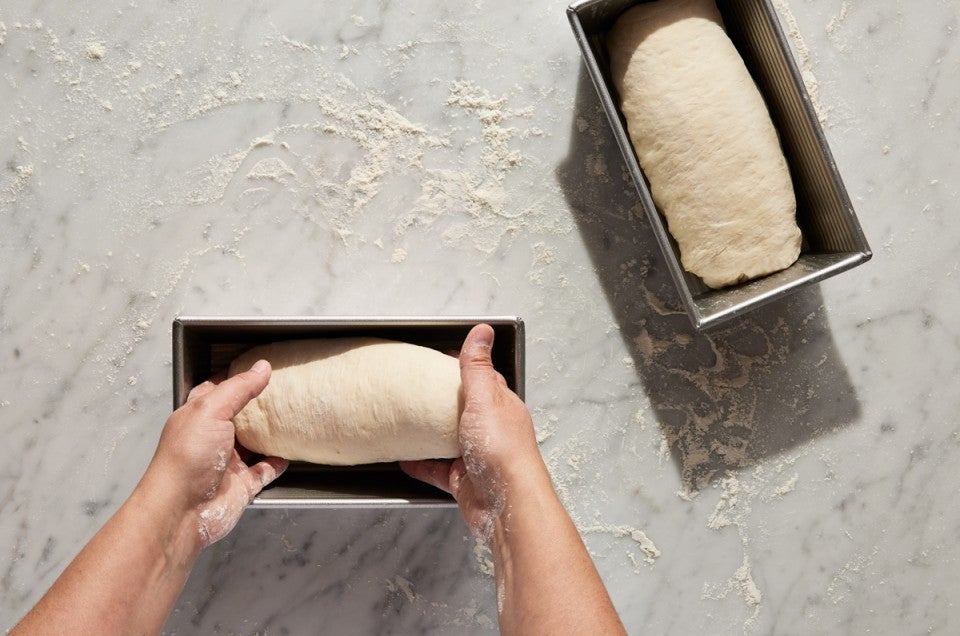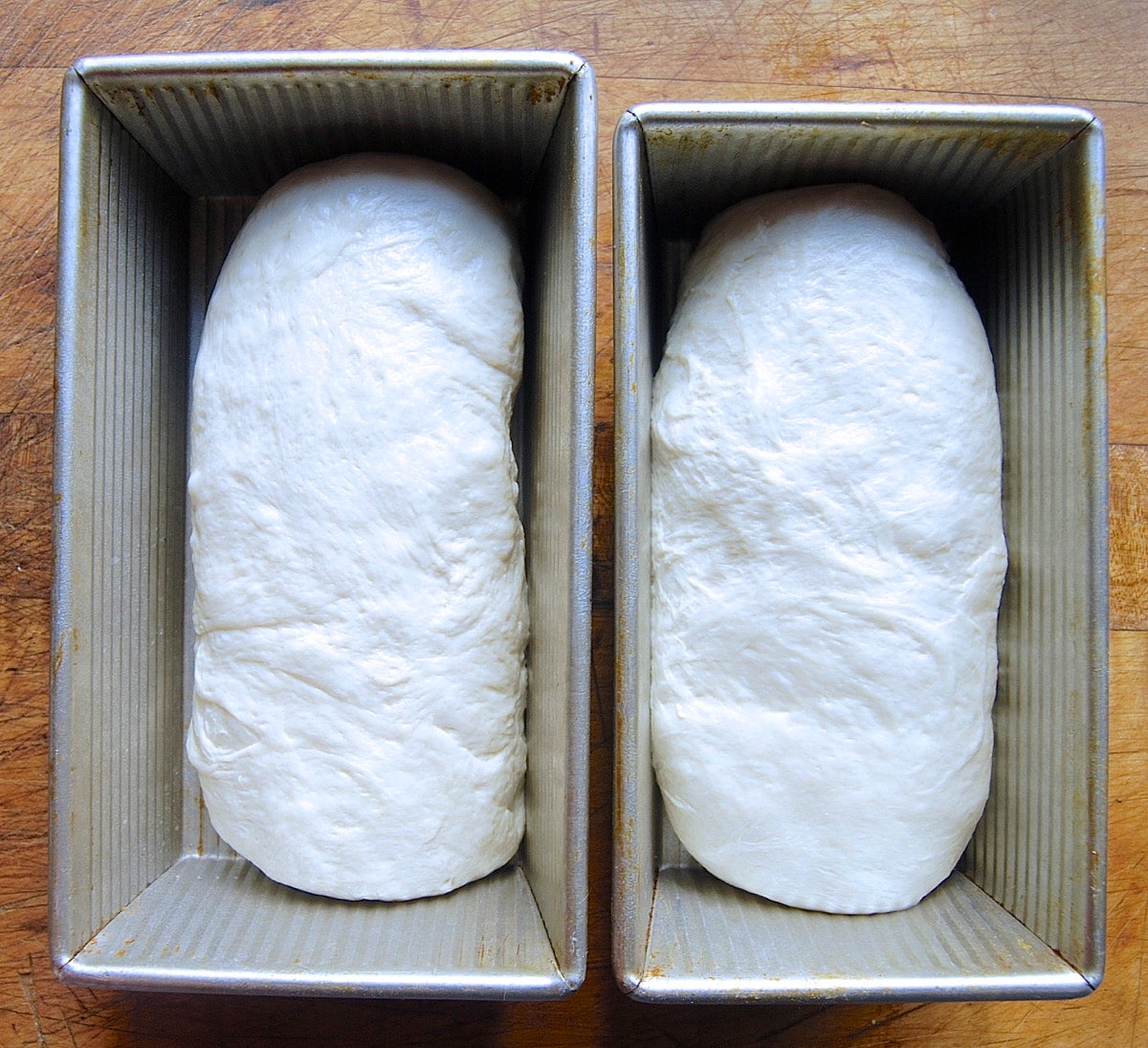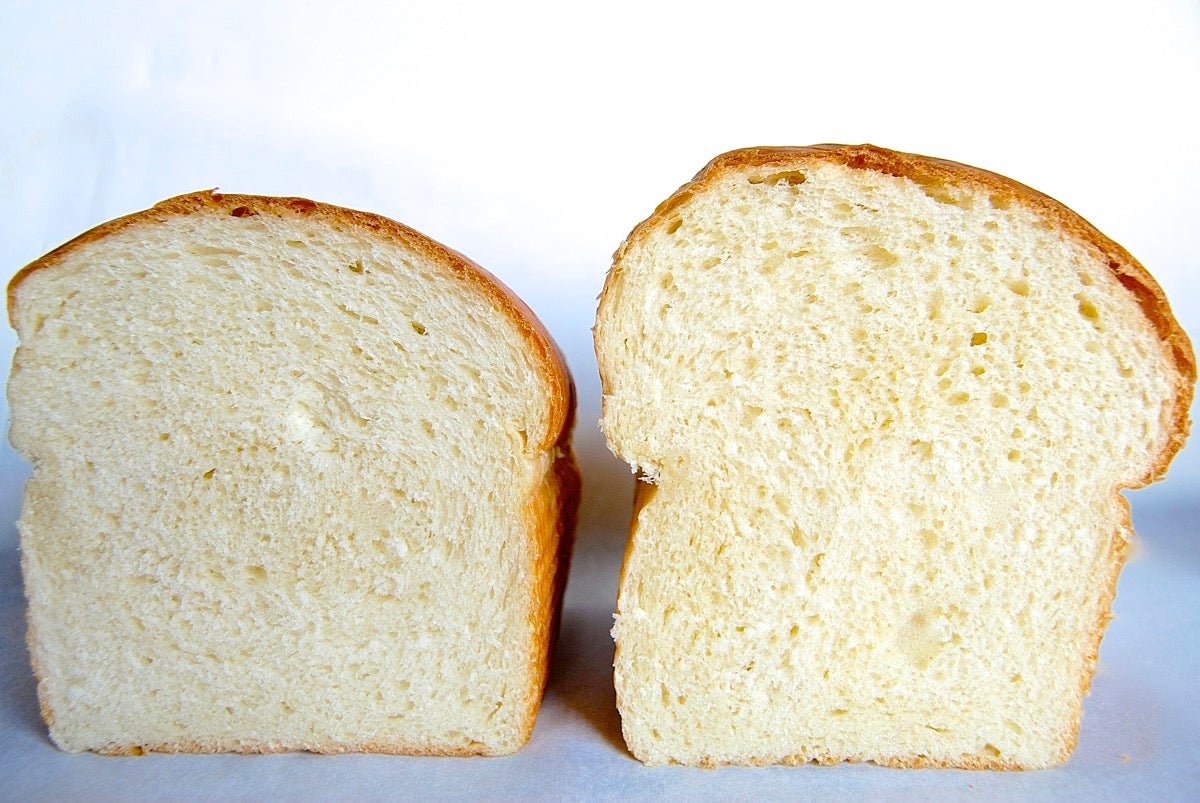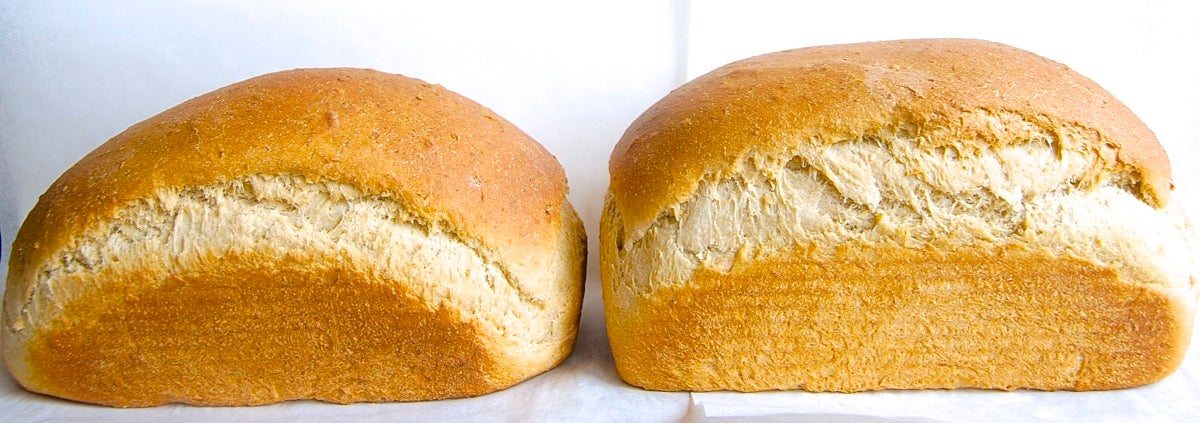


You’ve been baking yeast bread, but you’re not happy with the look of your loaves. They’re not the high-rising, domed beauties you expect, but instead are short and squat, producing slices that are more horizontal than vertical.
The solution to your problem may be as simple as choosing the right bread pan.
Bread loaf pans come in many sizes — from tiny minis for your holiday gift loaves to king-sized pain de mie pans capable of producing 2 1/2-pound loaves.
But the vast majority of yeast bread recipes call for one of two basic bread pan sizes: 9" x 5" or 8 1/2" x 4 1/2". Both of these bread pans are generally 2 1/2" tall; sometimes, they’re interchangeably referred to as a “loaf pan.”
That 1/2" difference on each side may not seem like a big distinction — viewed alone, these bread pans are hard to tell apart. Side by side, you'll notice the slight size variation.
But that 1/2" difference in each dimension translates to a 15% variation in capacity. In many cases, it means the difference between a nicely domed bread loaf and one that’s barely managed to crest the rim of the pan. So if a bread recipe calls for an 8 1/2" x 4 1/2" loaf pan, as many yeasted sandwich breads do, it’s important to use that exact size. (9" x 5" pans, meanwhile, are often used for quick breads.)
Let's bake our Classic Sandwich Bread to demonstrate.
We’ll start with a bowl of risen dough. It’s divvied exactly (right down to the last gram) between the bread pans and left to rise.

You can see that the dough in the 8 1/2" x 4 1/2" bread pan (right) is slightly taller, which makes sense; it has less volume to fill before peeking over the pan's rim.
The loaves get baked, and the one in the smaller bread pan definitely rises higher. In fact, it creates that classic mushroom-top shape that’s characteristic of sandwich breads.
To be fair, the 9" x 5" loaf on the left, though shorter, looks perfectly acceptable. You’ll still get nice bread, even if it has a different shape.
It's when you bake loaves that use a bit less flour than normal (under 3 cups) or whole-grain loaves that you might notice a more significant difference.
This is our Vermont Whole Wheat Oatmeal Honey Bread. It rises just slightly less high than our Classic Sandwich Bread. But see what a nice shape the 8 1/2" x 4 1/2" bread pan gives it (right), compared to the 9" x 5" ski-slope loaf on the left? That loaf’s heel ends won’t make very nice sandwiches.
See our complete guide to baking pans for more essential baking guidance >>
While there’s no hard-and-fast rule for “use this amount of dough in this size bread pan for the perfectly shaped loaf,” there are some basics you should know. First and foremost: If the recipe calls for a specific size bread loaf pan, use it! If the recipe doesn’t call for a specific size pan, but simply says “loaf pan,” use the following guidelines.
Do you have questions about yeast bread – or any other baking subject? Our Baker's Hotline is ready to help: 855-371-2253.
Cover photo by Mark Weinberg; food styling by Liz Neily.








January 12, 2023 at 5:52pm
Very nice and sweet
December 15, 2022 at 6:03pm
How is baking time and baking bread affected with ceramic bakeware?
December 17, 2022 at 10:03am
In reply to How is baking time and… by Doriselda Boone (not verified)
Hi Doriselda, we've found ceramic and stoneware baking pans can vary quite a bit in their baking properties, depending on the composition of the clay and other factors. This can make them a bit more unpredictable, but once you've learned how your pan bakes and adjusted accordingly, you can still get excellent results. Metal pans tend to transfer heat the best, and this could result in better oven spring when baking bread. For more about different types of pans and how they affect your baking, check out this blog post. We also have some helpful information about pan choices in this article.
November 21, 2022 at 9:34pm
Can you use a pizza pan when you make yeast rolls or do you have to have a certain type of pan to make yeast rolls
November 27, 2022 at 3:51pm
In reply to Can you use a pizza pan when… by Della Herrera (not verified)
Hi Della, any sort of baking pan or sheet pan can work for making yeast rolls. If you're planning to make individual rolls, I would recommend lining the pan with lightly greased parchment paper and spacing out the rolls so they have room to rise without touching. If you want to make pull apart rolls, a pan with sides (like a 9" X 13" pan, or one or two 9" cake pans) will work better than a pizza pan. The size of the pan will depend on how many rolls you are planning to make.
November 7, 2022 at 10:27am
I make Polish coffee cakes using the 9×5 loaf pan. I bake them at recommended 350° for 30-40 min. My question being I always have trouble with "over browning" and the center being "raw". I use parchment to line the pans but wonder if I am using the wrong size pans. My recipe uses yeast and 3 1/2 - 4 cups of flour. Any idea as to what I am doing wrong?
November 7, 2022 at 3:34pm
In reply to I make Polish coffee cakes… by Tina (not verified)
Hi Tina, no worries! Once your loaf has started to brown, you can simply tent the top with foil to help to prevent it from becoming too dark. This will prevent the top from over browning before the center has finished baking. Hope this helps!
September 12, 2022 at 1:50pm
Wow, I wish I'd found this blog sooner! I've been baking soft sandwich breads in the wrong pan and wondering why they came out so weird. I also now know which KA pan to use for quick breads which is helpful.
August 29, 2022 at 4:16pm
I’ve recently started baking bread and have been tweaking the spices in Beth Hensberger’s Swedish Rye Bread recipe which calls for 2 1/2 cups of rye flour and 2 1/2 cups AP or bread flour. The recipe says to form 2 oval loaves and bake on a sheet pan but I have been baking the 2 loaves in 8 1/2” x 4 1/2” pans and they come out pretty good, but maybe not quite as tall as I would like. Also, my family feels that the slices are too small for a good sandwich. I have a rye bread pan that I bought from King Arthur many years ago. It is approximately 12” x 5.5” x 2.5”. The volume is slightly less than twice the volume of two 8 1/2” x 4 1/2” pans (the rye bread pan held just a little less water than the 2 smaller pans).
I am going to try baking the full recipe in the rye bread pan. What other adjustments do you thing I might need to make.
August 29, 2022 at 4:42pm
In reply to I’ve recently started baking… by Elizabeth Schultz (not verified)
Hi Elizabeth, baking time will likely be longer when you bake one large loaf, but not double the time of two smaller loaves. I would check at the normal baking time, and reset the timer from there. Look for normal signs of doneness.
Pagination